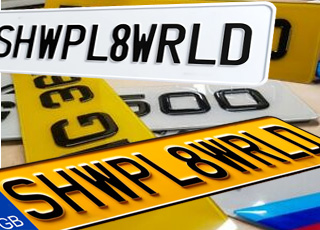As road users in the UK, you may already be familiar with vehicles having white number plates up front and yellow number plates in the back. If you just bought a car and registered it, you may have just discovered that it is required to have a white number plate on the front of your car and a yellow number plate on the rear. You may also be wondering whether it’s actually necessary and why.
All vehicles must show their number plates in order for other drivers and law enforcement to identify the vehicle. For example, the number plate is the easiest way to distinguish a specific car from others with the same colour, model, and design. Number plates are also used to identify a car in case of emergencies and legal matters that involve your vehicle. As a result, a number plate should be easily readable and clearly visible.
The white and yellow colours help to make the number plate easily visible and increase its readability. To give you a clearer picture, this article will provide you with an explanation of why number plates in the UK are white and yellow.
Rules of Displaying Number Plates
To better understand why the colour white and yellow on the number plates are important, it is essential to understand the rules for displaying number plates that are implemented by the Driver and Vehicle Licensing Agency (DVLA). Here are the rules for displaying number plates according to the DVLA:
- All the number plates on your vehicle must be made from a reflective material
- The front plate should display black characters on a white background
- The rear plate should display black characters on a yellow background
- All plates should not have any background pattern
- All plates should display the supplier of the number plate
- All plates should be marked with a British Standard number (‘BS AU 145e’ for plates registered after September 1, 2021)
Why Are the Rear Number Plates Yellow?
The UK government requires all number plates to be made from a reflective material. Yellow is a great colour to use with reflective materials because it adds contrast and draws attention to the number plate’s black lettering. Yellow has been found to respond to the brain more quickly than the majority of other colours, and it provides the best contrast with black, making it extremely obvious to anyone driving or watching behind the vehicle.
Why Are the Front Number Plates White?
The front number plate is usually viewed by drivers that are in front of you. If not looking directly at your car, drivers frequently look in their mirrors to see your number plate. Therefore, it’s crucial that the front plate can be seen clearly, especially during nighttime and in any kind of weather. The front plate should be white to prevent reflectors or continuous front lights from obstructing the view of the number plate. In addition, the reflective material of the plate will assist in making the black lettering on the white background more visible even in adverse weather, making it the ideal colour combination for a front plate.
Follow the White-and-Yellow-Plate Rule
The main function of a number plate is to enable fast and precise identification of its numbers and letters by other drivers and law enforcement officials. When a crime or accident involving a car happens, it offers the police a quick method to learn crucial information about the vehicle involved. More importantly, the rules have been established and made public — the use of a white number plate in front and a yellow number plate in the rear provide drivers on the road an incredibly solid and clear method to distinguish whether they are looking at the front or rear of a vehicle, particularly in severe weather conditions.
With this information, drivers and other road users can easily anticipate the likelihood that the vehicle is travelling either away from or in the direction of their own vehicle to avoid accidents. Following the rules set by the DVLA not only allows you to avoid penalties and fines from the authorities but also helps improve the safety and security of the UK road.


